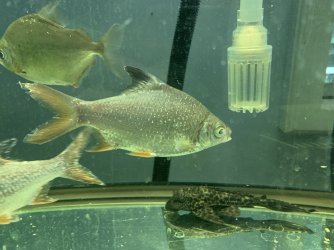Maracyn is an antibiotic and should only be used if there is a known bacterial infection that hasn't responded to other treatments.
Improper use and mis-use of antibiotics has lead to drug resistant bacteria that kill people, animals, birds, reptiles and fish.
External bacterial infections show up as red sores.
Internal bacterial infections are harder to identify.
It's highly unlikely your fish have a bacterial infection.
-------------------
INFORMATION WE REQUIRE TO HELP DIAGNOSE THE PROBLEM
What is the ammonia, nitrite, nitrate and pH of the water (in numbers)?
What sort of filter is on the aquarium?
How often and how do you clean the filter?
How often do you do water changes and how much do you change?
Do you dechlorinate the new water before adding it to the aquarium?
How long have the fish been covered in white stuff?
Have you added anything to the aquarium in the 2 weeks before this started?
Have you had visitors on the day this started or the day before it started?
What did you do to the aquarium on the day before this started?
-------------------
The fish are covered in excess mucous that is produced by the fish when they are stressed by something in the water. This can be chemicals from medication, plant fertiliser, aerosol sprays, paint fumes, etc. It is most commonly caused by poor water quality (ammonia, nitrite, nitrate).
-------------------
FIRST AID FOR FISH
Test the water for ammonia, nitrite, nitrate and pH.
Wipe the inside of the glass down with a clean fish sponge. This removes the biofilm on the glass and the biofilm will contain lots of harmful bacteria, fungus, protozoans and various other microscopic life forms.
Do a 75% water change and gravel clean the substrate every day for a week or until the problem is identified. The water changes and gravel cleaning will reduce the number of disease organisms in the water and provide a cleaner environment for the fish to recover in. It also removes a lot of the gunk and this means any medication can work on treating the fish instead of being wasted killing the pathogens in the gunk.
Make sure any new water is free of chlorine/ chloramine before it is added to the tank.
Clean the filter if it hasn't been done in the last 2 weeks. However, if the filter is less than 6 weeks old, do not clean it. Wash the filter materials/ media in a bucket of tank water and re-use the media. Tip the bucket of dirty water on the garden/ lawn. Cleaning the filter means less gunk and cleaner water with fewer pathogens so any medication (if needed) will work more effectively on the fish.
Increase surface turbulence/ aeration to maximise the dissolved oxygen in the water.



